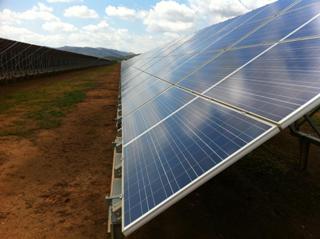Oct 20 2015
On Oct. 7, Gov. Jerry Brown of California signed legislation aimed at increasing renewable-energy generation. Among renewable energy systems, solar energy has high potential for mitigating climate change, resulting in diverse technologies that capture the sun's thermal energy.
 This photo shows a utility-scale solar energy installation in a shrubland ecosystem. Credit:R. Hernandez, UC Berkeley.
This photo shows a utility-scale solar energy installation in a shrubland ecosystem. Credit:R. Hernandez, UC Berkeley.
But big solar is far from transmission and demand loads, too close to protected areas, and is a driver of land-use and land-cover change, concludes a new study led by researchers at the University of California, Riverside.
"Our study, which focuses on California, shows that utility-scale solar energy development can be a driver of land-use and land-cover change, which is a source of greenhouse gas emissions itself," said Rebecca R. Hernandez, the lead researcher and a former junior specialist at UC Riverside who worked closely on the research with Michael F. Allen, the director of the Center for Conservation Biology (CCB). "We see this happening if solar energy power plants are sited in natural habitats, in lieu of areas already impacted by humans--such as on commercial rooftops or over parking lots."
According to Hernandez, the story began with a race and a tortoise, the race being the ramping up of solar energy development in California in response to climate change.
"At a time when many utility-scale solar energy developers would have liked to be celebrating their permit approvals to break ground on construction, they were confronted with the reality of a complex, arduous, and costly mitigation of environmental impacts, in which much of it was focused on the desert tortoise," she said. "Today, the development of natural land for solar energy generation is receiving attention not just for tortoises but whole ecosystems."
Study results appear online today (Oct. 19) in the Proceedings of the National Academy of Sciences.
"California's desert is the least understood of our major biomes, full of endemism and diversity," Allen said. "But we were observing extensive environmental damage, without understanding that simple, prudent siting of utility-scale solar energy installations could alleviate that damage. The first step is always to verify what we observe. This paper represents the careful analysis of the hypothesis that solar development, in particular, could be more appropriately distributed, for power, for carbon sequestration, and for biodiversity."
The researchers assessed siting impacts of 161 planned, under construction, and operating utility-scale solar energy (USSE) installations within California. They picked California to focus on because of its early and rapid deployment of solar energy systems, large energy demand, and diverse ecosystems. They found the majority of USSE in the state is sited in natural environments - shrub- and scrublands (375 square kilometers of change). Twenty-eight percent of these installations are located in croplands and pastures (155 square kilometers of change), illustrating that agricultural lands for renewable energy are being utilized.
The research team is currently studying solar energy in the Central Valley in greater depth, led by Madison K. Hoffacker, a co-author on the study and a junior specialist in CCB, to understand its potential for development and the extent to which farmers and agricultural landowners are putting down the plow and raising solar panels.
"We are seeing landowners, particularly in the Central Valley, shift from harvesting crops to harvesting the sun," Hoffacker said.
The study reveals that USSE development is a source of land-cover change and, based on its proximity to protected areas, may result in direct and indirect ecological consequences.
"These impacts may include increased non-native species invasions and compromised movement potential of species tracking habitat shifts in response to environmental disturbances, such as climate change," Hernandez said.
She emphasized the urgent need to optimize solar energy development.
"For centuries, we have literally had our heads in ground, digging holes for fossil fuels," she said. "This research provides a much-needed ruler to measure the sustainability and efficiency of renewable energy siting decisions. We have the data, technology, and economy to support a rapid and efficient solar energy transition without adverse environmental impacts. On the other hand, we have a dearth of understanding of how aridland ecosystems--ecosystems humans depend upon for their services--are restored with few success stories. Clearly, we need to raise our standards because the stakes are high and the consequences impact humans globally. Whatever we do here, in California, is going to be scrutinized or emulated elsewhere.
"In another study, we are quantifying the avoided carbon dioxide emissions associated with solar energy environmental co-benefit opportunities," she added.